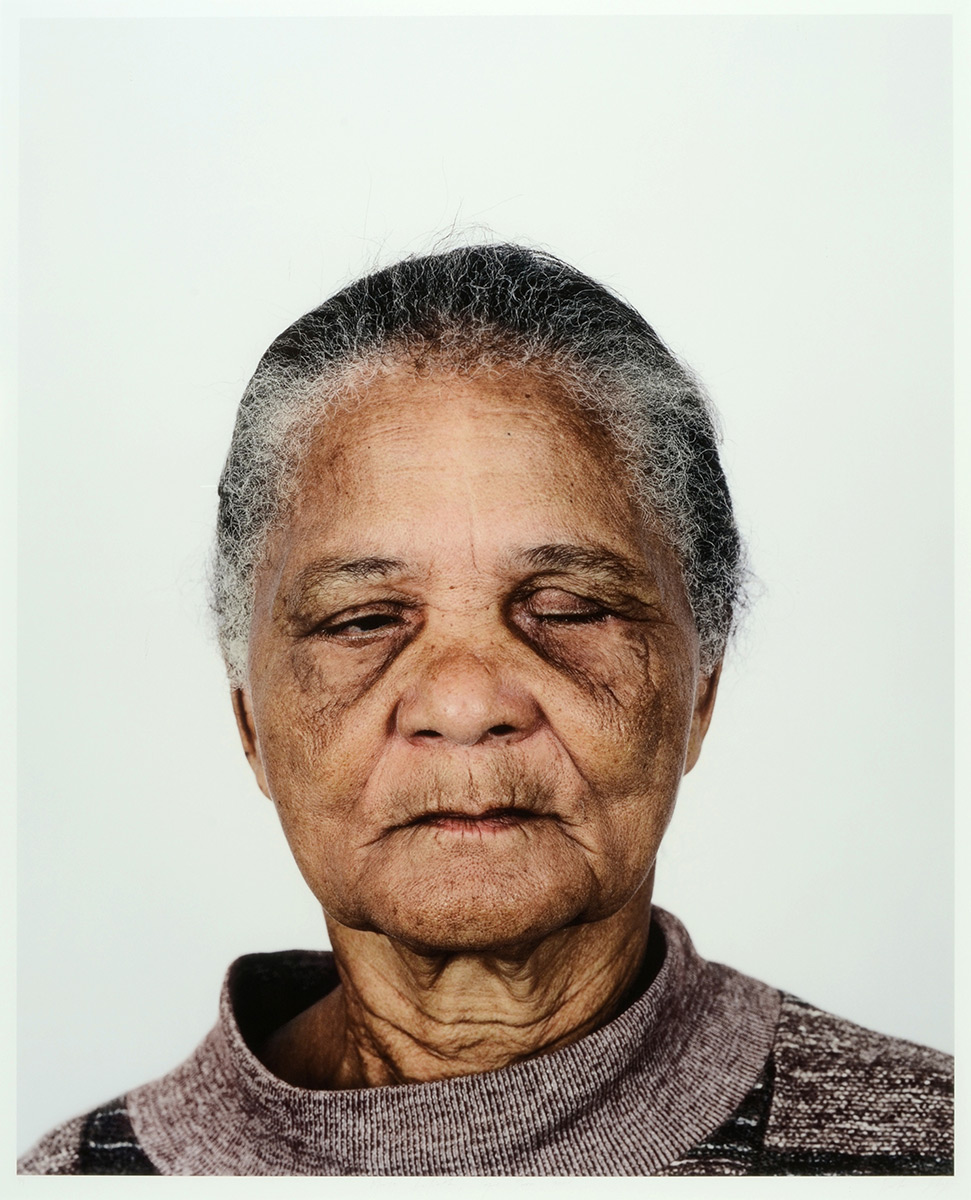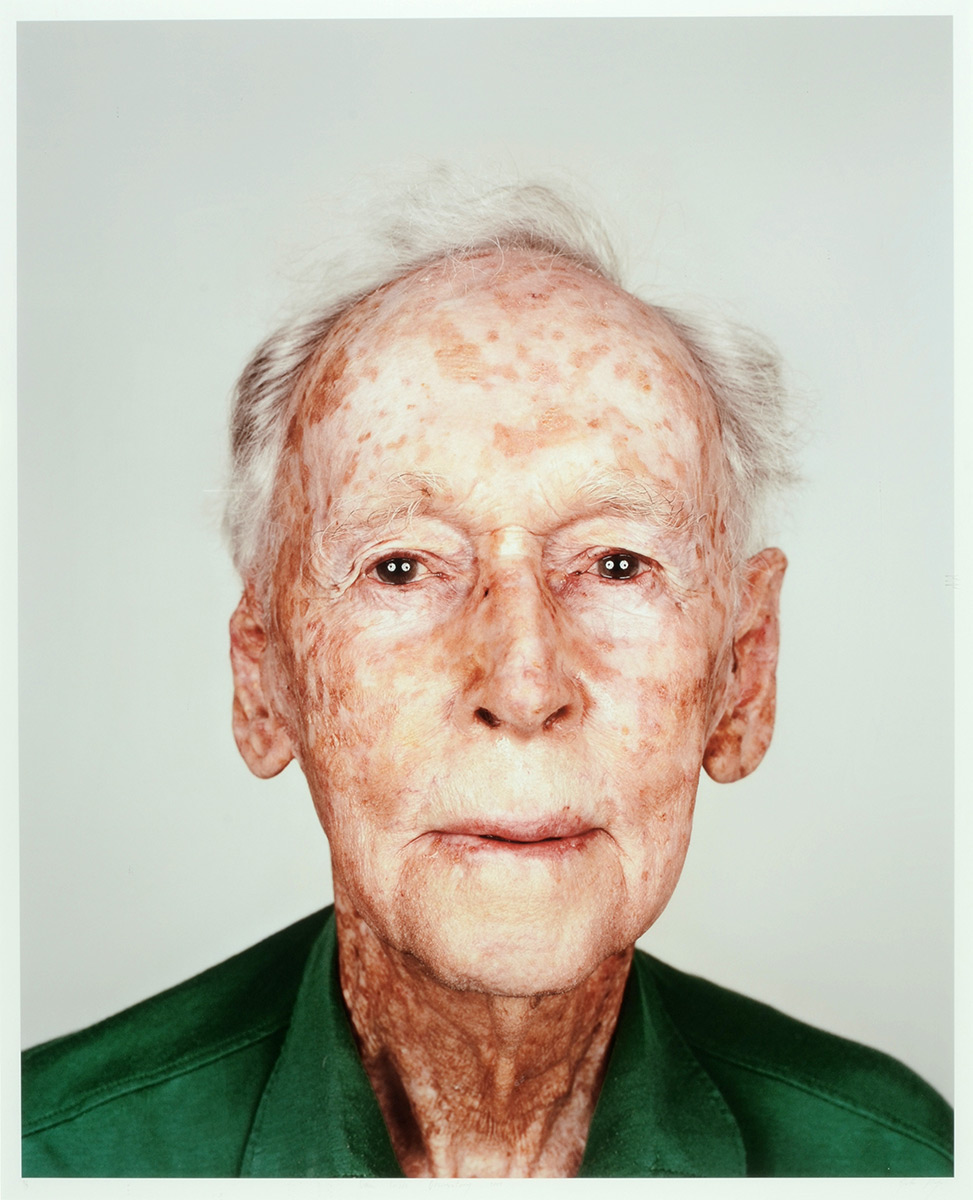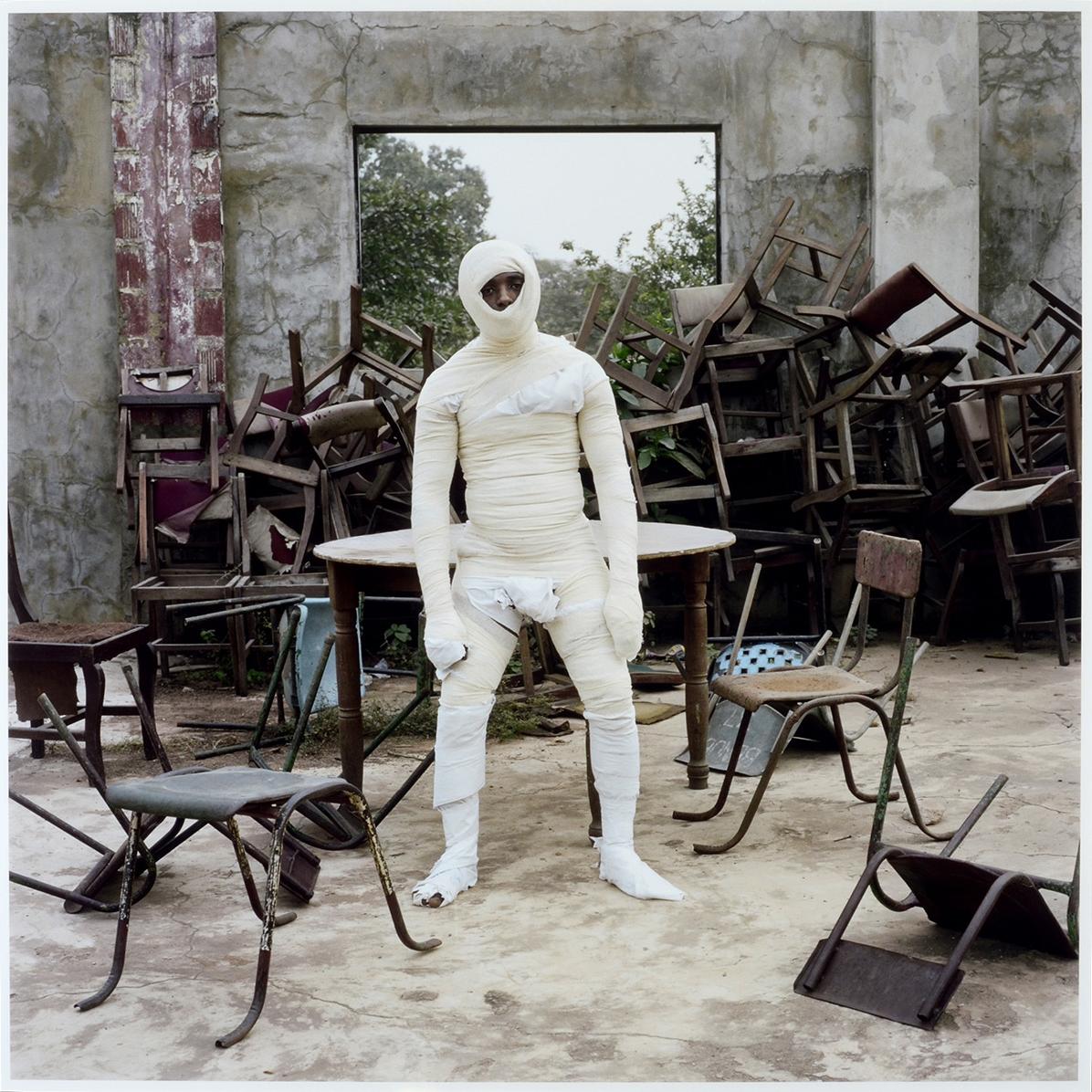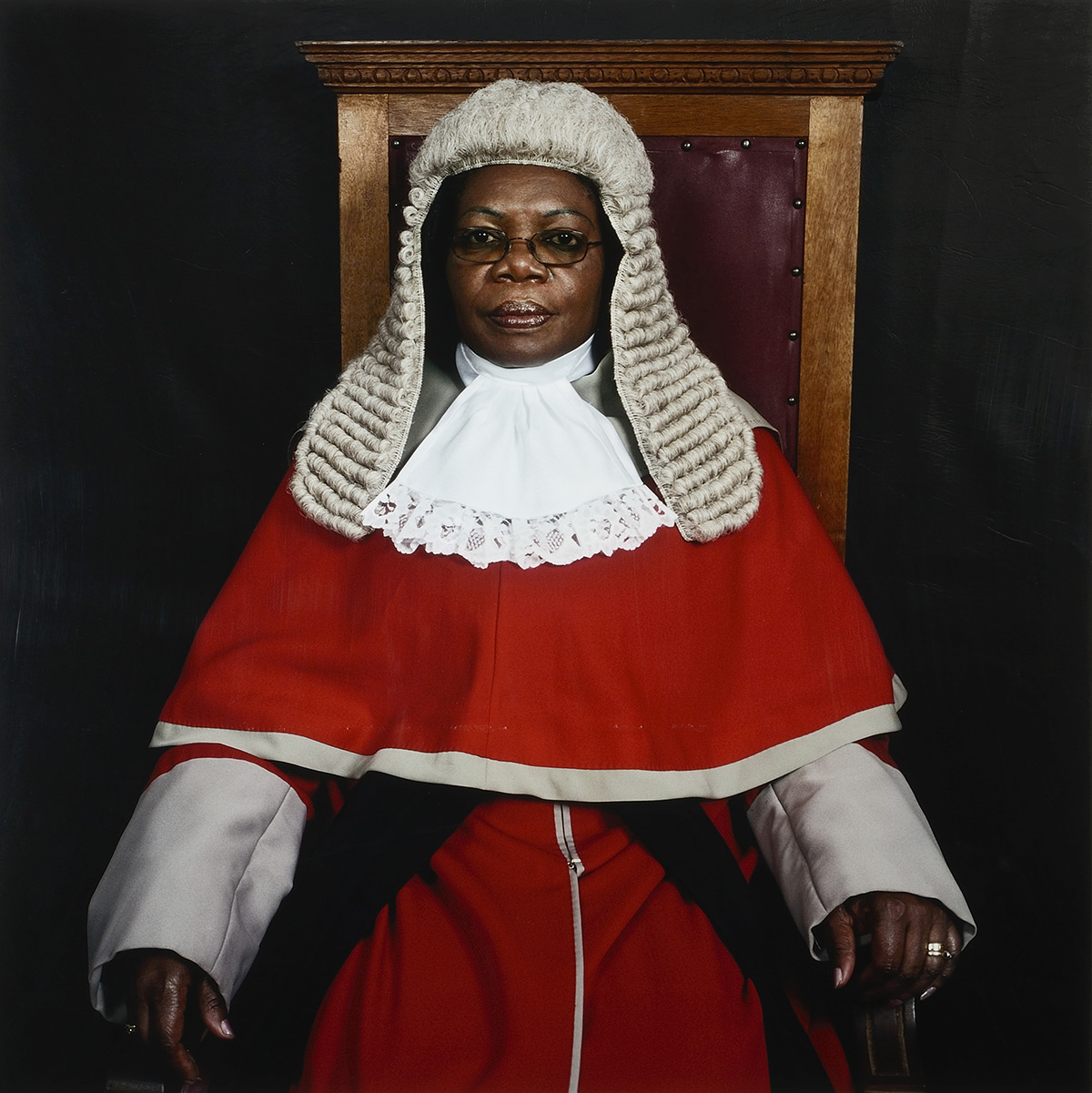Pieter HUGO (b. 1976)
Maria Goliath, Cape Town
2005
archival pigment on cotton rag paper
edition 1/3
100 x 80 cm
This portrait is part of Hugo’s Looking Aside series and draws attention to different kinds of blindness – actual blindness and willed blindness. In confronting the partial blindness of Maria Goliath – one eye obscured, the other squinting inwards – the reflex is to look away, but in so doing the viewer limits his/her/their own vision, momentarily blinding him/herself/themselves to the reality within the frame and, in effect, to the trials of the other.
‘In this ongoing series, Hugo looks directly at people whose appearance makes us look aside. In doing so, he forces us to confront ourselves and our preconceptions and prejudices, and question why we are so awkward when we encounter people who are unusual in some way, whether for reasons of albinism, blindness or a skin disorder. In these frontal portraits, we see what we usually choose to look at from the corners of our eyes,’ reads the exhibition statement.
SOURCE
http://www.stevenson.info/exhibitions/hugo/lookingaside.htm
Owen Knibbs, Observatory
2005
archival pigment on cotton rag paper
edition 1/3
100 x 80 cm
Along with the studio portrait of Maria Goliath, this frank and disarming portrait of Owen Knibbs is part of Hugo’s Looking Aside series. The photographer has purposely made no effort to soften the edges here. Instead, direct composition and lighting ensure that every blemish and every crease is visible on the aged face of the sitter. The harsh reality of aging and the unrelenting effects of sun exposure on pale skin are made visually manifest in the person of Owen Knibbs, who gazes directly at the viewer, stoically challenging him/her/them to see him exactly as he is.
In the text by Antjie Krog published in the book that accompanied this series, she writes:
But the clamouring suddenly comes from everywhere. These pages are filed with other people. Strange people. People one does not necessarily want to look at directly. Strangers for sidelong glances. People who are not one’s own.
Within the covers of a book, what possibility do they pose? Do they pose a risk for who we think ‘we’ are? Or do they restore the self into the ‘we’. And who are these people who call into question the definition of what we assume ‘we’ is?
They are outside the ‘we’. The way they are interrogates us… Continue Reading
Tarry King Ibuzo, Enugu, Nigeria
2008
C-print
edition 1/ 9 + 2 AP
104 X 104 cm
This outlandish image of a zombie-like bandaged figure in a wrecked and abandoned old café or classroom is part of Hugo’s Nollywood (2009) series in which he explores the multilayered reality of the Nigerian film industry. These staged representations feature local actors who recreate themes and characters from Nollywood films: young men in military fatigues; witch doctors, healers and saints; hunters with their kill; prostitutes in their rooms… The result is a series of surreal blurring of fact and fiction.
‘Nollywood is the third largest film industry in the world, releasing between 500 and 1 000 movies each year. It produces movies on its own terms, telling stories that appeal to and reflect the lives of its public: it is a rare instance of self-representation on such a scale in Africa. The continent has a rich tradition of storytelling that has been expressed abundantly through oral and written fiction, but has never been conveyed through the popular media before. Stars are local actors; plots confront the public with familiar situations of romance, comedy, witchcraft, bribery, prostitution. The narrative is overdramatic, deprived of happy endings, tragic. The aesthetic is loud, violent, excessive; nothing… Continue Reading
The Honourable Justice Julia
2005
lambda print
editione 1/5 + 1AP
100 x 100 cm
Hugo’s Portrait of the Honorable Justice Julia Sakardie-Mensah highlights the contradictions of personal/cultural identity that may be called into play for an individual occupying a position of public office. To what extent does the judge depicted identify with the white wig she is wearing; a flamboyant masculine symbol of judicial rank that has its origins in late-17th century Europe?
This portrait forms part of Hugo’s The Judges series, which presents portraits of African judges dressed in official regalia. The series was shot in Botswana in 2005. ‘[The series] was made during the final months of the longest running court case in Botswana’s history,’ reads a review of Pieter Hugo – Portraits (2008), an exhibition that was curated by Autograph ABP in collaboration with Open Eye Gallery, Liverpool with the support of the Michael Stevenson Gallery, Cape Town. ‘A group of Bushmen had accused the government of illegally evicting them in order to exploit the diamond and mineral potential of the Central Kalahari Game Reserve. In a landmark ruling, the three member High Court ruled that the Bushmen were entitled to live and hunt on their ancestral lands. These studies, alluding to the imperatives of authoritarian portraiture, turn lazy… Continue Reading
BIOGRAPHY
Born in Johannesburg, based in Cape Town, Pieter Hugo is a photographic artist whose work merges documentary, portraiture, still life and landscape, directly tackling loaded issues around representation in photography.
Hugo worked in the Cape Town film industry before spending two years at Fabrica, a research centre for creatives in Italy. He is a self-taught artist who draws inspiration from both art historical traditions and documentary styles. He is primarily a portrait photographer whose work explores themes such as identity, class, race, culture, and privilege.
As Aperture magazine observes, ‘Hugo manoeuvres through the muddy waters of political engagement, documentary responsibility, and the relationship of these to his own aesthetic.’
He is best known for his dramatic 2007 series, The Hyena & Other Men, which depicts the nomadic lives of Nigeria’s gadawan kura (hyena handlers), who use the animals to entertain crowds. He has also photographed Rwandan landscapes, scavengers at a toxic dump in Ghana, the Nollywood film industry, and family and friends.
Major museum solo exhibitions have taken place at The Hague Museum of Photography, Musée de l’Elysée in Lausanne, Ludwig Museum in Budapest, Fotografiska in Stockholm, MAXXI in Rome and the Institute of Modern Art Brisbane, among others. Hugo has participated in numerous group exhibitions at institutions including Tate Modern, the Folkwang Museum, Fundação Calouste Gulbenkian, and the São Paulo Bienal. His work is represented in prominent public and private collections, among them the Museum of Modern Art, V&A Museum, San Francisco Museum of Modern Art, Metropolitan Museum of Modern Art, J Paul Getty Museum, Walther Collection, Deutsche Börse Group, Folkwang Museum and Huis Marseille.
Hugo received the Discovery Award at the Rencontres d’Arles Festival and the KLM Paul Huf Award in 2008, the Seydou Keita Award at the Rencontres de Bamako African Photography Biennial in 2011, and was shortlisted for the Deutsche Börse Photography Prize 2012.
His work can be found in many public and private collections, including Centre Pompidou, Paris, France; Rijksmuseum, Amsterdam, The Netherlands; V&A Museum, London, UK; J Paul Getty Museum, Los Angeles, CA, USA; the Museum of Modern Art and Metropolitan Museum of Modern Art, New York City, NY, USA.





